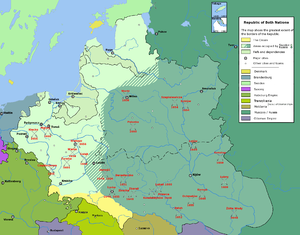
Back الطوفان (تاريخ) Arabic Tufan (tarix) Azerbaijani توفان (تاریخ) AZB Шведскі патоп Byelorussian Швэдзкі патоп BE-X-OLD Шведски потоп Bulgarian Potop Breton Diluvi (Polònia) Catalan Švédská invaze do Polska Czech Karl 10. Gustavs polske krig Danish
This article needs additional citations for verification. (February 2024) |
| The Deluge | |||||||||
|---|---|---|---|---|---|---|---|---|---|
| Part of Northern Wars (Second Northern War and the 1654–1667 Russo-Polish War) | |||||||||
 The occupation of the Commonwealth by Sweden, Russia, Brandenburg and Khmelnytsky's Cossacks | |||||||||
| |||||||||
| Belligerents | |||||||||
|
| ||||||||
| Commanders and leaders | |||||||||
| Strength | |||||||||
| 69,000 | 191,000[5] | ||||||||
| Casualties and losses | |||||||||
| Total dead: 3,000,000–4,000,000[6] | |||||||||
The Deluge (Polish: potop szwedzki, Lithuanian: švedų tvanas) was a series of mid-17th-century military campaigns in the Polish–Lithuanian Commonwealth. In a wider sense, it applies to the period between the Khmelnytsky Uprising of 1648 and the Truce of Andrusovo in 1667, comprising the Polish theatres of the Russo-Polish and Second Northern Wars.[7] In a stricter sense, the term refers to the Swedish invasion and occupation of the Commonwealth as a theatre of the Second Northern War (1655–1660) only; in Poland and Lithuania this period is called the Swedish Deluge (Polish: potop szwedzki, Lithuanian: švedų tvanas, Swedish: Svenska syndafloden), or less commonly the Russo–Swedish Deluge (Polish: Potop szwedzko-rosyjski)[8][better source needed] due to the simultaneous Russo-Polish War.[9] The term "deluge" (potop in Polish) was popularized by Henryk Sienkiewicz in his novel The Deluge (1886).
During the wars the Commonwealth lost approximately one third of its population as well as its status as a great power due to invasions by Sweden and Russia.[10] According to Professor Andrzej Rottermund, manager of the Royal Castle in Warsaw, the destruction of Poland in the Deluge was more extensive than the destruction of the country in World War II. Rottermund claims that Swedish invaders robbed the Commonwealth of its most important riches, and most of the stolen items never returned to Poland.[11] Warsaw, the capital of the Polish–Lithuanian Commonwealth, was destroyed by the Swedes, and out of a pre-war population of 20,000, only 2,000 remained in the city after the war.[12] According to the 2012 Polish estimates, the material damage caused by the Swedish army amounted to 4 billion złotys. 188 cities and towns, 186 villages, 136 churches, 89 palaces, and 81 castles were completely destroyed in Poland.[13]
- ^ Ervin Liptai: Military history of Hungary, Zrínyi Military Publisher, 1985. ISBN 963-326-337-9
- ^ a b László Markó: Lordships of the Hungarian State, Magyar Könyvklub Publisher, 2000. ISBN 963-547-085-1
- ^ Palka, Piotr. "Potop szwedzki – jedna z największych tragedii w dziejach Polski". Wszystko co Najważniejsze (in Polish).
Although the Commonwealth was in the camp of the victors and defended its existence, it suffered unimaginable losses
- ^ "Adolf Johan". sok.riksarkivet.se. Retrieved September 13, 2023.
- ^ Claes-Göran Isacson, Karl X Gustavs Krig (2002) Lund, Historiska Media. p. 96. ISBN 91-89442-57-1
- ^ Polska Akademia Nauk, Polska w okresie drugiej wojny północnej, 1957, p=271-280
- ^ Subtelny, Orest (1988). Ukraine. A history. Cambridge University Press. p. 104.
- ^ "Potop szwedzko-rosyjski, czyli III wojna północna (Swedish-Russian Deluge, or the Third Northern War)". polskieradio.pl. June 1, 2018. Archived from the original on January 6, 2018. Retrieved June 10, 2018.
- ^ Frost, Robert I (2004). After the Deluge. Poland-Lithuania and the Second Northern War, 1655–1660. Cambridge Studies in Early Modern History. Cambridge University Press. p. 3. ISBN 0-521-54402-5. Archived from the original on May 2, 2023. Retrieved September 16, 2018.
- ^ Zawadzki, Marcin. "Durham University Polish Society". Durham University. Archived from the original on August 21, 2007. Retrieved June 23, 2009.
During 'The Deluge', Commonwealth lost an estimated ⅓ of its population (proportionally higher losses than during World War II), and its status as a great power.
- ^ ""Nikt tak nie ograbił Polski jak Szwedzi"". PolskieRadio.pl.
- ^ "Pierwsze zniszczenie Warszawy i jej odbudowa po potopie 1655–1696". www.wilanow-palac.pl. Archived from the original on January 27, 2020. Retrieved December 25, 2021.
- ^ "Potop szwedzki przyniósł Polsce straty o wartości 4 mld złotych". dzieje.pl. Archived from the original on June 27, 2018. Retrieved December 25, 2021.